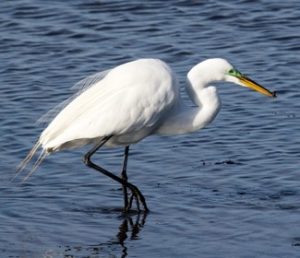
Clinging jellyfish (Gonionemus vertens) have been spotted at the Jersey shore in 2016. A native of the Pacific Ocean, this dime-sized jellyfish species was accidentally introduced to Atlantic coastal waters in Massachusetts in the late 1800s. Previously unreported in New Jersey, they may be new invaders here, or just not noticed until now due to relatively low population numbers.
Although not observed in the Barnegat Bay yet, they have been found in the Shrewsbury and Manasquan Rivers. Their presence in the Manasquan is of concern, since it connects to the northern part of the bay through the Point Pleasant canal. (Photo courtesy of Anul Khanal, Montclair University)
Why we are concerned about the presence of clinging jellyfish in our area
Despite its small size, this highly venomous species packs a powerful and painful sting that can have serious health consequences. Each mature clinging jellyfish has from 60 to 90 tentacles loaded with stinging capsules called nematocysts, which release neurotoxins when triggered. According to the Woods Hole Oceanographic Institute and other experts, the venom from clinging jellyfish can cause acute respiratory problems, joint and muscle pain, dermatitis, and even kidney failure in severe cases. In June, a resident of Middletown, NJ spent three days in the hospital after being stung while swimming in the Shrewsbury River.
The NJ Department of Environmental Protection (NJDEP) clinging jellyfish fact sheet summarizes what we know about this species and how to avoid getting stung. Clinging jellyfish prefer shallow, calm vegetated habitats in bays and tidal rivers. Pads on their tentacles enable them to cling to eelgrass, macroalgae, and other shallow-water plants. They typically cling to vegetation during the day, becoming more active at night as they move into the water column to feed on zooplankton (tiny animals in the water). Staying out of their preferred habitat is the best defense, and anyone clamming or wading near these vegetated areas should wear protective clothing, such as waders and neoprene gloves.
What someone should do if stung by a clinging jellyfish
The NJDEP fact sheet recommends the following:
1. Apply white vinegar to the affected area to immobilize any remaining stinging cells.
2. Rinse the area with salt water and remove any remaining tentacle materials using gloves, a plastic card or thick towel.
3. Cold packs or ice can then be applied to alleviate pain. A hot compress may also be effective.
4. If symptoms persist or pain increases instead of subsiding, seek prompt medical attention.
Unanswered questions about this species
Scientists have much to learn about Gonionemus vertens and are asking several important questions about this species. Is the population increasing along the eastern Atlantic coast? Are there different subspecies with variations in the toxicity of the venom? Are clinging jellyfish in Atlantic coastal waters evolving to become more venomous?
While more research is needed, scientists suspect clinging jellyfish populations have been increasing in the Atlantic coastal region in recent years and are examining environmental factors that may be contributing to this apparent increase. Overfishing may be reducing the populations of predators of this species, causing an increase in clinging jellyfish numbers. Increased levels of nitrogen in coastal waters from fertilizer and sewage runoff may be contributing to higher numbers of clinging jellyfish by increasing their food source – nitrogen promotes the growth of algae in coastal waters, and copepods (the preferred food of clinging jellyfish) feed on algae.
Monitoring for the presence of clinging jellyfish
Scientists from the NJDEP’s Division of Science, Research and Environmental Health have been monitoring to try to determine how widespread the population is in New Jersey. Dr. Paul Bologna and Dr. Jack Gaynor, researchers with the Montclair University Marine Biology and Coastal Sciences Program, have been studying jellyfish species in New Jersey for many years and are working with the NJDEP on tracking the location of clinging jellyfish populations in NJ. Plankton tows and seining in seagrass beds are two of the methods being used to monitor for their presence.
Barnegat Bay Partnership researchers will also be monitoring for the presence of Gonionemus vertens in the Barnegat Bay as part of a long-term monitoring project which assesses variations in the abundance and distribution of juvenile fish species and jellyfish in the central and northern portions of the bay.

